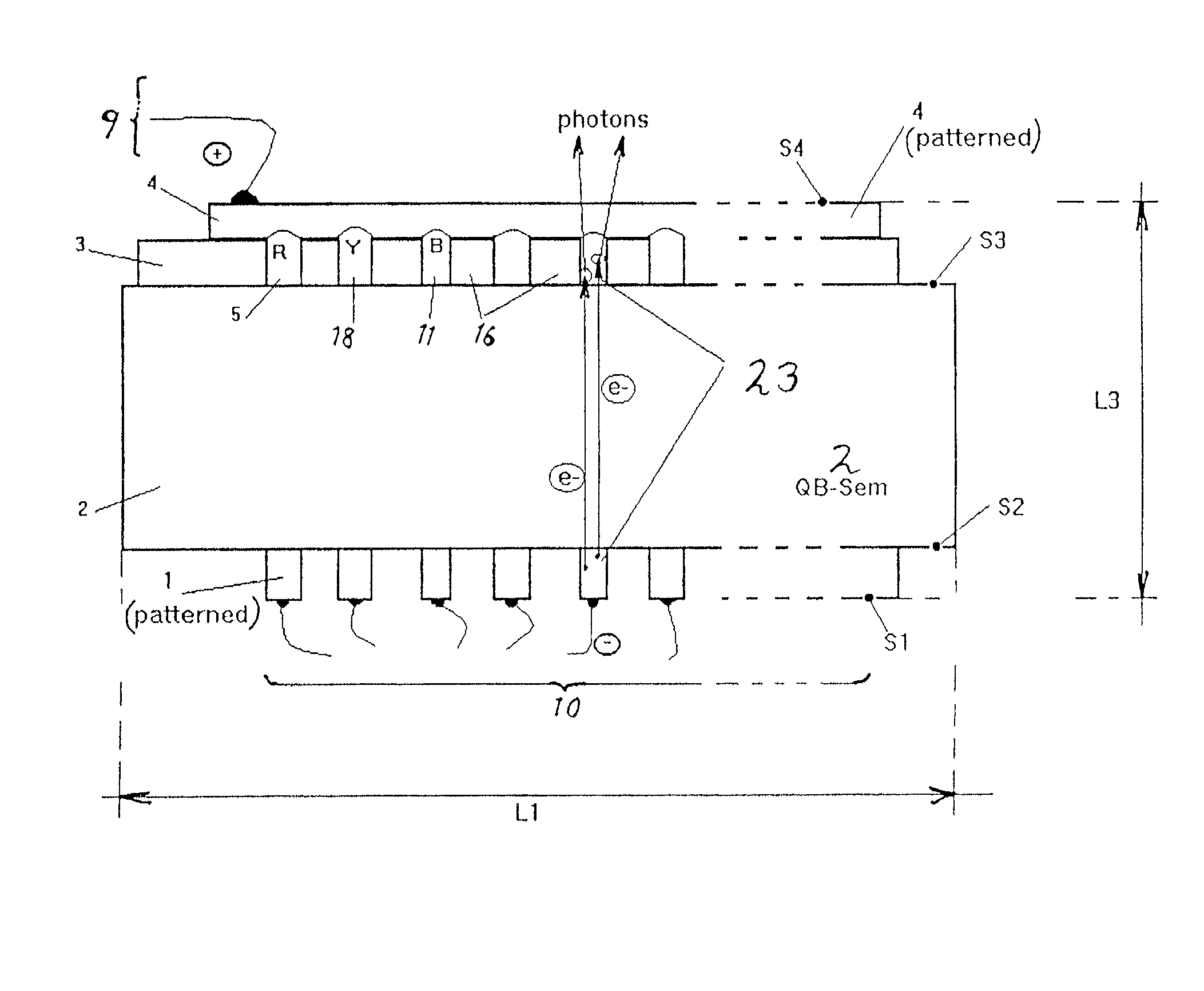Planar electron emitter (PEE)
a technology of electron emitter and electron beam, which is applied in the manufacture of electric discharge tubes/lamps, tubes with screens, discharge tubes luminescnet screens, etc., can solve the problems of unreliable, non-recognizable ballistic electrons in highly resistive semiconductors or insulators, and non-recognizable quasi-ballistic electrons in high resistive materials
- Summary
- Abstract
- Description
- Claims
- Application Information
AI Technical Summary
Benefits of technology
Problems solved by technology
Method used
Image
Examples
example 1
Field Emission Flat Panel Displays (FE-FPD)
[0209]One of the obvious applications of the present invention is its use in the construction of robust, reliable, large, low power dissipation and cheap Field Emission Flat Panel Displays (FE-FPD).
[0210]FIG. 4, which is a cross-sectional diagram along the line A-A of the FE-FPD shown in FIG. 5 is one of the possible vacuum-less FE-FPDs according to the present invention With reference to FIG. 3, the basic planar structure of the present invention—1 (cathode), 2 (QB-Sem) and 4 (anode—optically transparent in this preferred embodiment) is clearly apparent also in FIG. 4. The only difference is that in this Flat Panel Display application of the present invention the cathode and the anode are patterned and that an extra layer 3 is introduced between the surface S3 of the QB-semiconductor and the anode 4. This third layer consists of alternative (patterned) segments of red 5, yellow 18 and blue 11 phosphors or other colour light emitting lumino...
example 2
Planar Electron Beam Lithography
[0219]By using the planar electron emitter according to the present invention the major drawback imposed by the short lifetime of the prior art planar electron emitters, are solved. The present invention offers a qualitatively new and robust solution to the present day needs of the semiconductor industry. The method and the embodiment are described in FIGS. 9 to 14.
[0220]The schematic diagram of the principle behind the Planar Electron Beam Lithography, was described in the prior art using FIG. 8. In the prior art, an electron lithographic projection system has been demonstrated using a prior art planar electron emitter. The planar electron emitter of the present invention can be directly implemented in place of the prior art emitter.
[0221]One possible embodiment according to the present invention of such a planar electron emitter structure is shown in FIG. 10. The major difference from prior art FIG. 8 is the replacement of a thin film oxide layer 24...
example 3
Two-Dimensional Illumination Panels
[0226]Due to the simplicity of design, robustness, low power dissipation, low temperature operation and two-dimensional nature of the planar electron emitter according to the present invention, the said planar electron emitter can be used very conveniently in the construction of two-dimensional (planar and non-planar) illumination sources.
[0227]One such possible flat illumination panel is shown schematically in FIGS. 15 and 16. Here the basic structure of the planar electron emitter (cathode 1, QB-semiconductor 2 and the anode 4) is used as planar source of electrons (when an appropriate electrical voltage is applied between the cathode and the anode) emerging into the free space FS. These electrons are accelerated within this space by means of the accelerating electrode 7 and enter the light emitting layer 3. The optically transparent plate 13 (typically a glass plate) that allows the generated light to escape from the said structure forms (togeth...
PUM
 Login to View More
Login to View More Abstract
Description
Claims
Application Information
 Login to View More
Login to View More - R&D
- Intellectual Property
- Life Sciences
- Materials
- Tech Scout
- Unparalleled Data Quality
- Higher Quality Content
- 60% Fewer Hallucinations
Browse by: Latest US Patents, China's latest patents, Technical Efficacy Thesaurus, Application Domain, Technology Topic, Popular Technical Reports.
© 2025 PatSnap. All rights reserved.Legal|Privacy policy|Modern Slavery Act Transparency Statement|Sitemap|About US| Contact US: help@patsnap.com



